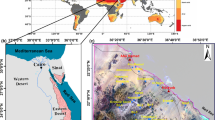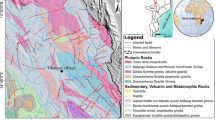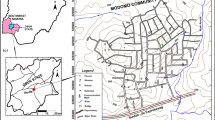Abstract
Airborne magnetic data and Landsat imagery, as well as time-domain electromagnetic soundings, were used to assess groundwater potential of the region around the town of Mafikeng in North West Province, South Africa. Lineaments were extracted based on on-screen digital data derived from magnetic and Landsat 7 imagery. The relationship between lineament-intersection density and borehole yield was assessed using statistical analysis. The results were discussed with respect to factors that determine the groundwater potential of the area. Correlation between lineament-intersection frequency and borehole yield is 60–65% in the south and southeastern parts, and 45–50% within 5–30 km radius of Mafikeng. The eastern and western parts of the study area are characterized by weak or no correlation. Areas that correspond to high correlation between lineament-intersection frequency and borehole yield suggest the significance of cross-cutting structures in controlling groundwater potential zones, while results that suggest low or no correlation represent the influence of other factors. The overall results demonstrate that the combined analysis of airborne magnetic data, satellite imagery, borehole yield and ground-based time-domain electromagnetic soundings provide the best approach for groundwater assessment within the hard rock and carbonate terrains of the study area.
Résumé
Des données magnétiques aéroportées et de l’imagerie LANDSAT, ainsi que des sondages TDEM ont été utilisés pour évaluer le potentiel en eau souterraine de la région située autour de de la ville de Mafikeng dans la province du Nord-Ouest, Afrique du Sud. Les linéaments ont été extraits à l’écran à partir de données numériques dérivées de l’imagerie Landsat 7 et magnétique. La relation entre la densité des intersections de linéaments et le débit des forages a été évaluée en utilisant une analyse statistique. Les résultats ont été discutés en fonction des facteurs qui déterminent le potentiel en eau souterraine de la région. La corrélation entre la fréquence des intersections de linéaments et le débit des forages est de 60–65% dans les zones sud et sud-est et de 45–50% dans un rayon de 5–30 km autour de Mafikeng. Les zones Est et Ouest de la région d’étude sont caractérisées par une faible corrélation ou l’absence de corrélation. Les zones qui correspondent à une forte corrélation entre la fréquence des intersections de linéaments et le débit des forages suggèrent le rôle significatif des structures sécantes en termes de contrôle des zones de potentiel en eau souterraine, tandis que les résultats qui suggèrent une faible ou l’absence de corrélation représentent l’influence d’autres facteurs. Les résultats globaux démontrent que l’analyse combinée de données magnétiques aéroportées, imagerie satellite, débit des forages et sondages TDEM sur le terrain fournissent la meilleure approche pour la recherche d’eau souterraine au sein des roches de socle et des terrains carbonatés de la région d’étude.
Zusammenfassung
Aeromagnetische Messdaten, Landsat Aufnahmen und am Boden ausgeführte transientenelektromagnetische Sondierungen wurden im Rahmen einer Bewertung des Grundwasserpotentials in der Umgebung der Stadt Mafikeng, Nordwest Provinz, Südafrika, eingesetzt. Die aeromagnetischen Daten wurden zusammen mit den Landsat Aufnahmen benötigt, um das Störungs-und Bruchzonenmuster des Untersuchungsgebietes zu identifizieren. Das Verhältnis von Lineamentschnittpunkthäufigkeit zu Brunnenförderrate wurde statistisch ausgewertet. Das Ergebnis wird anhand von Faktoren erörtert, mit denen sich das Grundwasserpotential des Gebietes bestimmen lässt. Es ergibt sich ein Korrelationskoeffizient von 60–65% zwischen Schnittpunkthäufigkeit und Brunnenförderrate in den südlichen und südostwärtigen Teilen des Untersuchungsgebietes und von nur 45–50% innerhalb eines Gebietes mit einem zwischen fünf und dreißig Kilometer variierenden Radius um die Stadt Mafikeng herum. In den ostwärtigen und westlichen Teilen des Untersuchungsgebiets sind dagegen Schnittpunkthäufigkeit und Brunnenförderrate gar nicht bzw. nur unwesentlich korreliert. Hohe Korrelation von Schnittpunkthäufigkeit mit Brunnenförderrate wird als Hinweis auf erhöhtes Grundwasserpotential gewertet, während in Arealen mit schwacher oder keiner Korrelation die Brunnenförderrate durch andere Faktoren bestimmt ist. Als Gesamtergebnis ist festzuhalten, dass sich die integrierte Auswertung von aeromagnetischen Messungen, Satellitenbildern, Brunnenförderraten und transientelektromagnetischen Sondierungen als erfolgversprechende Vorgehensweise zur Bestimmung des Grundwasserpotentials von karbonatischen Festgesteinsaquifern bewiesen hat.
Resumen
Se utilizaron datos magnéticos aéreos y las imágenes Landsat, así como sondeos electromagnéticos en el dominio del tiempo, para evaluar el potencial de agua subterránea de la región cercana a la ciudad de Mafikeng en la Provincia del Noroeste, Sudáfrica. Los lineamientos fueron extraídos en base a los datos digitales de pantalla derivados imágenes magnéticas y Landsat 7. Se evaluó la relación entre la densidad de intersección de lineamientos y el rendimiento de los pozos usando un análisis estadístico. Los resultados se discutieron con respecto a factores que determinan el potencial de agua subterránea del área. La correlación entre la frecuencia de intersección de lineamientos y el rendimiento de los pozos es 60–65% en las partes sur y sureste, y 45–50% dentro de un radio de 5–30 km de Mafikeng. Las partes este y oeste del área de estudio están caracterizadas por una correlación débil o nula. Las áreas que corresponden a alta correlación entre la frecuencia de la intersección de los lineamientos y el rendimiento de los pozos sugieren la importancia de las estructuras transversales de corte para controlar las zonas potenciales de agua subterránea, mientras que una baja o ninguna correlación sugieren la influencia de otros factores. El resultado general demuestra que el análisis combinado de datos magnéticos aéreos, imágenes satelitales, rendimientos de pozos y sondeos electromagnéticos en el dominio del tiempo con base en tierra proporcionan la mejor aproximación para la evaluación de agua subterránea dentro de las rocas duras y terrenos carbonáticos del área de estudio.
موجز
استعملت المعطيات المأخوذة عن طريق جهاز المغناطيسية المحمول جوا، وصور القمر الصناعي لاندسات، و السبر الكهرومغناطيسي الممثل بالمجال الزمني، استعملت لتقييم احتمالات وجود المياه الجوفية بالمنطقة المحاذية لمدينة مافيكينغ بمقاطعة الشمال الغربي لدولة جنوب إفريقيا. تم استخراج الرسوم الأولية اعتمادا على البيانات الرقمية على الشاشة المستمدة من الصور المغناطيسية وصور القمر الصناعي لاندسات7. تم تقييم العلاقة بين كثافة تقاطع الرسوم الأولية و مردودية الثقوب المائية باستخدام التحليل الإحصائي. نوقشت النتائج أخدا بعين الاعتبار العوامل التي تحدد احتمالات وجود المياه الجوفية بالمنطقة. العلاقة المتبادلة ما بين تردد تقاطع الرسوم الأولية و مردودية الثقوب المائية هي: 60–65% بالجنوب و المناطق الجنوبية الشرقية، و45–50% داخل دائرة يمتد نصف قطرها من 5 إلى 30 كلم حول مدينة مافيكينغ. وتتميز الأجزاء الشرقية والغربية من منطقة الدراسة بعلاقة ضعيفة أو معدومة. تشير المناطق ذات العلاقة المتبادلة بين تردد تقاطع الرسوم الأولية و مردودية الثقوب المائية إلى أهمية البنى المتشعبة في مراقبة المناطق المحتمل تواجد المياه الجوفية بها بينما تمثل النتائج التي تشير إلى علاقة متبادلة ضعيفة أو معدومة تأثير عوامل أخرى. تثبت النتائج العامة أن التحليل المشترك للمعطيات المأخوذة عن طريق جهاز المغناطيسية المحمول جوا، وصور القمر الصناعي، ومردودية الثقوب المائية ، و السبر الكهرومغناطيسي الممثل بالمجال الزمني و القائم على أرض الواقع يقدم أفضل مقاربة لتقييم المياه الجوفية داخل الصخور الصلبة و الحقول الكربونية لمنطقة الدراسة.
摘要
本文利用空间地磁数据、陆地卫星成像以及时域电磁测深评价南非西北部省Mafikeng镇周围区域的地下水开采潜力。线性构造是从基于起源于地磁及Landsat 7成像的屏幕数字数据中提取出来的。利用统计分析评估线性构造交叉密度和井孔出水量之间的关系。结果对于决定该区地下水开采潜力的因素进行讨论。线性构造交叉频率与钻孔产量之间的相关性在南部及东南部区域是60–65%,Mafikeng地区的 5–30km半径范围内是45–50%。研究区的东部和西部以弱相关性或无相关性为特征。线性构造交叉频率与井孔出水量之间具有高相关性的区域表明了横断构造对地下水开采潜力区控制的重要性,低相关性或者无相关性的结果代表其他因素的影响。总的结果证明在研究区硬岩石及碳酸盐地形中空间地磁数据、卫星成像及陆基时域电磁测深为地下水评价提供了最好的方法。
Abstrakt
Dane magnetyczne zebrane z pokładu samolotu badawczego, zdjęcia Landsatu oraz electromagnetyczne sondowanie w domenie czasu zostały wykorzystane do oceny potencjału wód podziemnych w regionie miasta Mafikeng w północno-zachodniej prowincji RPA. Struktury liniowe uzyskano w wyniku interpretacji danych magnetycznych i zdjęć z Landsatu 7. Związek między częstotliwością występowania przecięć struktur liniowych i danych z odwiertów oceniono uzywajac narzedzi analizy statystycznej. Wyniki zostały omówione w odniesieniu do czynników, które określają potęncjał wód podziemnych w regionie. Korelacja pomiędzy częstotliwością występowania przecięć struktur liniowych z danymi z odwiertów wynosi 60–65% na południu i południowym wschodzie od Mafikengu oraz 45–50% w promieniu 5–30 km od Mafikengu. We wschodniej i zachodniej część badanego obszaru zaobserwowano słabą korelację lub jej brak. Obszary z wysoką korelacją między częstotliwością występowania przecieć struktur linowych z danymi z odwiertów sugerują istnienie znacznych struktur przekrojowych, które kontrolują występowanie strefy wód podziemnych-inne czynniki nie maja wpływu. Wyniki uzyskane w czasie badan wykazaly, że połączenie analizy danych magnetycznych ze zdjęciami satelitarnymi i danymi z odwiertów, a także uwzglednienie pomiarow electromgnetycznych jest najwłaściwszym podejściem do oszacowania występowania wód gruntowych w skałach twardych.
Resumo
Foram utilizados dados magnéticos aéreos e imagens Landsat, bem como sondagens eletromagnéticas no domínio do tempo, para avaliar o potencial hídrico subterrâneo na região da cidade de Mafikeng, na Província do Noroeste, África do Sul. Foram mapeados lineamentos com base nos dados digitais em ecrã derivados das imagens magnéticas e de Landsat 7. A relação entre a densidade de interseções de lineamentos e as produtividades dos furos foi avaliada com base em análise estatística. Os resultados foram discutidos no que respeita a fatores que determinam o potencial hídrico subterrâneo da área. A correlação entre a frequência de interseção de lineamentos e produtividade do furo é de 60–65% nas zonas sul e sudeste, e 45–50% num raio de 5–30 km de Mafikeng. As zonas oriental e ocidental da área de estudo caraterizam-se por uma correlação fraca ou inexistente. Nas áreas onde a correlação entre frequência de interseção de lineamentos e produtividade do furo é elevada, este fato sugere a importância das estruturas transversais no controlo do potencial hídrico subterrâneo, enquanto nas áreas de correlação baixa ou inexistente deve haver outros fatores influentes. Os resultados globais demonstram que a análise conjunta de dados magnéticos aéreos, imagens de satélite, produtividades de furos e sondagens eletromagnéticas terrestres no domínio do tempo fornece a melhor abordagem para a avaliação das águas subterrâneas nos meios fissurados e carbonatados da área de estudo.











Similar content being viewed by others
References
Astier RJ (1987) The development of crystalline basement aquifers in a tropical environment. Quat J Eng Geol 20:265–272
Astier JL, Paterson NR (1989) Hydrogeological interest of aeromagnetic maps in crystalline and metamorphic areas. In: Garland GD (eds) Proceedings of Exploration ’87. Ontario Geological Survey, Special volume 3, OGS, Sudbury, ON, pp 732–745
Blakely RJ (1995) Potential theory in gravity and magnetic applications. Cambridge University Press, Cambridge, 441 pp
Cambel G, Johnson S, Bakaya T, Kumar NJ (2006) Airborne geophysical mapping of aquifer water quality and structural controls in the Lower Okavango Delat, Botswana. S African J Geol 109:475–494
Clark L (1985) Groundwater abstraction from basement complex areas of Africa. Quat J Eng Geol 18:25–34
Cook PG (2003) A guide in regional groundwater flow in fractured aquifers. CISRO Technical Report, CSIRO Glen Osmond Land and Water, SA, Australia, pp 1–5
Danielsen JE, Dahlin T, Owen R (2007) Geophysical and hydrogeological investigation of groundwater in the Karoo stratigraphic sequence at Sawmills in northern Matabeleland Zimbabwe: a case history. Hydrogeol J 15:945–960
Edet AE, Okereke CS, Teme SC, Esu EO (1998) Application of remote-sensing data to groundwater exploration: a case study of the Cross River State, southeastern Nigeria. Hydrogeol J 6:394–404
Erikson, PG, Altermann, W, Hartzer, FJ (2006) The Transvaal Supergroup and its precursors. In: Johnson MR, Anhaeusser CR, Thomas RJ (eds) The Geology of South Africa, Geological Society of South Africa, Johannesburg, pp 237–260
Henkel H, Guzmann M (1977) Magnetic features of fracture zones. Geoexploration 15:173–181
Hood P (1965) Gradient measurements in aeromagnetic surveys. Geophysics 30:891–902
Hossam H, Elewa A, Quaddah A (2011) Groundwater potentiality mapping in the Sinai Peninsula, Egypt, using remote sensing and GIS-watershed-based modelling. Hydrogeology J 19: 613-628
Isaaks EH, Srivastava RM (1989) An introduction to applied geostatistics. Oxford University Press, Oxford
Keyser N, Du Plessis CP (1993) The geology of the Vryburg area. Explanatory note, Geological Survey of South Africa, Pretoria
Leica Geosystems GIS, Mapping LLC (2010) ERDAS Field Guide, vol 1. Leica Geosystems Geospatial Imaging, Norcross, GA
Michaluk E, Moen HFG (1991) The geology of the Mafikeng area. Explanatory note, Geological Survey of South Africa, Pretoria
Milzow C, Kgotlhang L, Bauer-Gottwein P, Meier P, Kinzelbach W (2009) Regional review: the hydrology of the Okavango Delta, Botswana: processes, data and modeling. Hydrogeol J 17:1297–1328
Moore GK, Hollyday EF (1975) Prospecting for groundwater with SKYLAB photographs, central Tennessee. Rem Sens Earth Resour 4:499–519
Salman AAB (1983) Using Landsat imagery interpretation for underground water prospection around Qena Province. Egypt Int J Rem Sens 4:179–189
Sander P (2007) Lineaments in groundwater exploration: a review of applications and limitations. Hydrogeol J 15:71–74
Srivastava PK, Bhattacharya AK (2006) Groundwater assessment through an integrated approach using remote sensing GIS and resistivity techniques: a case study from a hard terrain. Int J Rem Sens 27:4599–4620
Stauffer D, Aharony A (1994) Introduction to percolation theory, 2nd edn. Taylor and Francis, London, 181 pp
Tam VT, Batelaam O (2011) A multi-analysis remote-sensing approach for mapping groundwater resource in the Karstic Meo Vac Valley, Vietnam. Hydogeol J 19:275–287
Van Dyk GS, Jonck F (2000) 1:500,000 scale hydrogeological map series of the Republic of South Africa, Vryburg Sheet, Republic of South Africa, Pretoria
Vegter JR (2001) Groundwater development in South Africa: an introduction to the hydrogeology of groundwater. Report No. TT 134/00, Water Research Commission, Pretoria
Winter H (1976) A lithostratigraphic classification of the Ventersdorp Succession. Trans Geol Soc S Africa 79:31–48
Ziel P, Volk P, Saradeth S (1991) Geophysical methods for lineament studies in groundwater exploration: a case study from SE Botswana. Geoexploration 27:65–177
Acknowledgements
Many thanks to the Department of Water Affairs in the town of Mafikeng for providing access to the data from the borehole drilled west of Mafikeng. The Council for Geoscience is greatly acknowledged for funding the fieldwork and making the airborne magnetic data available. The authors wish to express their gratitude to the Department of Water Affairs at the Head Office in Pretoria for providing access to the borehole location, borehole yield and rainfall intensity data. Vunganai Midzi is greatly acknowledged for constructive comments to the earlier draft of the manuscript. We extend our great appreciation to the Editor, Associate Editor, S. White and anonymous reviewer for many valuable comments which improved the manuscript. A. Y. Billay, D. Eberle, M. Bensid and A. Cichowicz are greatly acknowledged for translating the title and abstract into German, Arabic and Polish languages. We thank S. Duncan for improving the scientific format and HJ style of presentation. Matome and Melvin are greatly acknowledged for assisting during the fieldwork. The local people around Mafikeng were helpful in locating the geographical position of boreholes used in interpretation of the time-domain electromagnetic soundings.
Author information
Authors and Affiliations
Corresponding author
Rights and permissions
About this article
Cite this article
Tessema, A., Mengistu, H., Chirenje, E. et al. The relationship between lineaments and borehole yield in North West Province, South Africa: results from geophysical studies. Hydrogeol J 20, 351–368 (2012). https://doi.org/10.1007/s10040-011-0803-5
Received:
Accepted:
Published:
Issue Date:
DOI: https://doi.org/10.1007/s10040-011-0803-5




